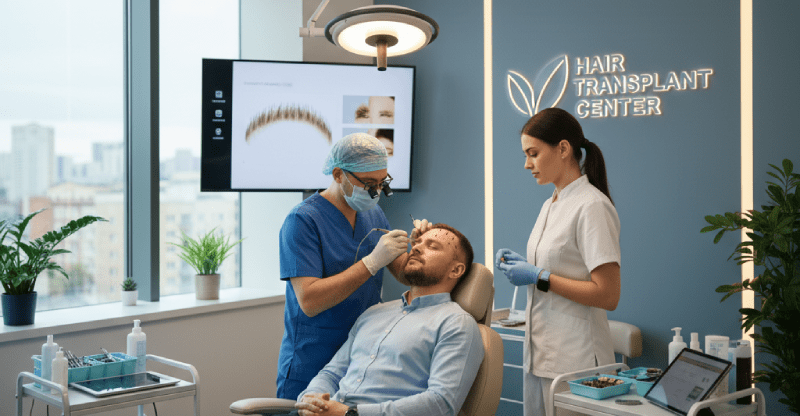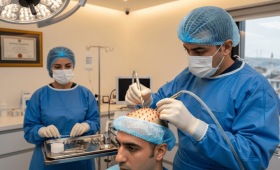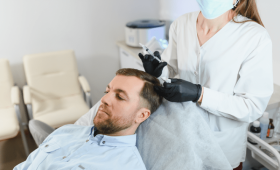HAIR TRANSPLANT PRICE COMPARISON: TURKEY VS. USA
What is the typical cost of a hair transplant in Turkey? Hair transplant procedures in Turkey are globally recognized for their exceptionally affordable prices, which generally range between $2,000 and $5,000. This cost often includes an all-inclusive package, a significant factor for international patients.
These comprehensive packages typically cover the surgical procedure, such as FUE or DHI, as well as essential logistical elements like accommodation in a high-quality hotel, ground transportation, and necessary post-operative care kits. This bundled pricing model provides a transparent and predictable total cost, which is a major advantage for patients planning their medical journey.
How do hair transplant prices in the United States compare?
In stark contrast to Turkey, hair transplant costs in the United States are considerably higher, often starting from $8,000 and potentially exceeding $20,000. The U.S. pricing model is usually based on a per-graft fee, with each graft costing anywhere from $3 to $15. This per-graft model can lead to a much higher final bill, especially for patients requiring a large number of grafts to achieve their desired density. Furthermore, the quoted price in the U.S. often only covers the surgery itself, with all other expenses being billed separately.
Why is the cost of a hair transplant so much cheaper in Turkey?
The significant cost difference is not a reflection of lower quality but rather of different economic and healthcare structures. Turkey benefits from a lower cost of living and a favorable exchange rate for international currencies. The government also actively promotes medical tourism, which drives competition among clinics and keeps prices competitive. The high volume of procedures performed by Turkish surgeons allows them to operate more efficiently, passing those savings on to the patient and making world-class procedures accessible to a wider audience.
Does a lower price in Turkey mean lower quality?
No, a lower price in Turkey does not automatically mean lower quality. The country has established itself as a global leader in hair restoration, with many clinics and surgeons holding international accreditations and extensive experience. Due to the sheer volume of patients, Turkish surgeons often perform hundreds of procedures annually, refining their skills to a high degree. It is crucial for patients to conduct thorough research to select a reputable and certified clinic, but the lower cost is primarily a result of the country’s economic advantages.
What is included in an all-inclusive package?
An all-inclusive hair transplant package in Turkey is designed to simplify the patient’s entire journey. These packages typically include a free consultation, the hair transplant procedure (FUE or DHI), all necessary medications and aftercare products, VIP transfers between the airport, hotel, and clinic, and a multi-night stay at a high-quality hotel. Some premium packages may also include additional treatments like Platelet-Rich Plasma (PRP) therapy or interpreter services to ensure a seamless and stress-free experience for the patient.
Are the hair transplant techniques the same in both Turkey and the United States?
Yes, the advanced hair transplant techniques utilized in both countries are largely identical. Both Turkish and U.S. clinics commonly perform Follicular Unit Extraction (FUE) and Direct Hair Implantation (DHI). These modern methods offer natural-looking results and minimal scarring. While some U.S. clinics may offer robotic-assisted FUE, Turkish clinics often specialize in a high volume of manual and DHI procedures with a high degree of precision, ensuring that the patient can receive the exact technique they need for a successful outcome regardless of location.

How long is the recovery time after a hair transplant?
The initial recovery period is relatively short. Within the first two weeks, patients will see crusts forming and falling off, and any swelling or redness will subside. The transplanted hair will then shed, which is a normal and expected part of the process. New hair growth becomes visible around the three-to-four-month mark, with the most significant improvements seen between six and nine months. The final results, showcasing full density and maturation, can be expected around 12 to 18 months post-procedure.
Will my transplanted hair look natural?
When the procedure is performed by a skilled and experienced surgeon, the results are designed to look completely natural and undetectable. A qualified surgeon’s expertise lies in their ability to meticulously design the new hairline to match the patient’s facial structure and to implant each hair follicle with the correct angle, direction, and density. This attention to detail ensures that the transplanted hair grows in a natural pattern that seamlessly blends with the existing hair.
Are the results of a hair transplant permanent?
The results of a hair transplant are considered permanent. This is because the hair follicles used for the procedure are sourced from the donor area, typically the back and sides of the head, which are genetically resistant to the effects of DHT, the hormone that causes pattern baldness. Once these follicles are transplanted to the balding areas, they maintain this resistance and continue to grow for the rest of your life. This makes a hair transplant a long-term investment in a fuller head of hair.
What are the potential risks and side effects of a hair transplant?
A hair transplant is a safe, minimally invasive procedure, but it is not without potential minor side effects. Patients may experience temporary swelling, redness, and a tight sensation in the scalp for a few days. Less common side effects can include itching, numbness, and mild pain, all of which are manageable with prescribed medication. Serious complications are rare but can include infection or a poor graft survival rate. Adhering to all post-operative instructions is the best way to minimize these risks.
Can women get a hair transplant?
Yes, women are often excellent candidates for hair transplants, particularly if their hair loss is caused by female pattern baldness or traction alopecia. The suitability of the procedure depends on a thorough analysis of the patient’s hair loss pattern and the health of their donor area. The DHI or FUE techniques can be used to add density to thinning areas, and in some cases, a “shave-free” technique is an option for women who do not want to shave their head for the procedure.
At what age can I get a hair transplant?
While there is no strict age limit, most medical professionals recommend that patients wait until at least age 25 to consider a hair transplant. This is because hair loss patterns, especially in men, can continue to evolve in the early twenties. Waiting allows a surgeon to accurately assess a stable hair loss pattern and create a long-term, natural-looking hairline. A comprehensive consultation is necessary to determine the ideal timing for each individual’s procedure.
How many grafts will I need?
The number of grafts needed varies greatly from person to person. It is determined by several factors, including the extent of your hair loss, the size of the area to be treated, and the density of your donor hair. A professional hair transplant surgeon will use a diagnostic tool to examine your scalp and provide a precise graft count during your initial consultation. This number is critical for both the procedure’s success and the total cost.
Will I be left with scarring?
With modern FUE and DHI techniques, visible scarring is minimal. Unlike the older FUT method, which leaves a linear scar, FUE and DHI leave tiny, pinpoint scars that are virtually invisible, even with very short hair. These micro-scars typically fade over time and are easily hidden by the surrounding hair. A surgeon’s expertise in harvesting grafts correctly is key to minimizing any potential scarring in the donor area.
Is the procedure painful?
The hair transplant procedure is generally painless. Before the surgery begins, the surgeon will administer local anesthesia to both the donor and recipient areas of the scalp. This numbs the area completely, ensuring that you do not feel any pain during the graft extraction and implantation process. Some patients may report a feeling of slight pressure or discomfort, but it is not considered a painful experience. Any post-operative discomfort can be managed with prescribed painkillers.
How long does the entire procedure take?
The duration of a hair transplant procedure is dependent on the number of grafts to be transplanted. A standard session can range from four to eight hours. For very large cases requiring thousands of grafts, the surgery may be divided into two sessions over consecutive days to ensure patient comfort and optimal results. The time is spent meticulously extracting and placing each individual hair follicle to achieve a natural and dense outcome.
Do I have to shave my head for a hair transplant?
In most standard FUE and DHI procedures, the donor area on the back of the head is shaved to allow for precise graft extraction. However, many clinics, particularly in Turkey, offer a “shave-free” option for patients who prefer to keep their hair long. This is usually suitable for smaller cases and requires the surgeon to meticulously work around the existing hair, which can increase the time of the procedure but helps maintain discretion.
When will my new hair start to grow?
After the initial shedding phase, which typically occurs within the first two to four weeks, new hair growth begins around three months post-surgery. This growth will be fine and thin at first. It will gradually thicken and mature over the coming months. Patients can expect to see significant cosmetic improvements between six to nine months, with the full and final result becoming apparent at one year. Patience is a key factor in the success of a hair transplant.
What should I avoid after the procedure?
To ensure the successful survival of the transplanted grafts, patients must adhere to specific aftercare instructions. You should avoid strenuous exercise, heavy sweating, direct sun exposure, and swimming for at least two to four weeks. Additionally, it is essential to avoid alcohol and smoking for at least a week, as these can negatively impact blood flow and the healing process. Your doctor will provide a detailed list of activities to avoid.
How do I choose the right clinic and surgeon?
Choosing the right clinic and surgeon is the most critical step in your hair transplant journey. It is essential to research the surgeon’s qualifications, experience, and specialization. Look for clinics that are transparent with their pricing, provide comprehensive all-inclusive packages, and have a strong portfolio of before-and-after photos. Reading patient testimonials and reviews on independent forums can also provide valuable insight into the clinic’s reputation and patient satisfaction.
Is the hair transplant procedure covered by insurance?
In most cases, a hair transplant is considered an elective cosmetic procedure and is not covered by health insurance in either the United States or Turkey. This is a primary reason why many patients seek affordable options abroad. While some specific medical conditions may qualify for coverage, it is extremely rare. Patients should plan to cover the cost out-of-pocket, which is made more feasible by Turkey’s cost-effective packages.
What is a hair graft?
A hair graft is a small piece of tissue containing one or more hair follicles. A single follicular unit can contain anywhere from one to four hairs, depending on the person. In a hair transplant, these grafts are meticulously harvested from the donor area and then transplanted to the balding or thinning areas. The term “graft” is a key metric in a hair transplant, as the total number of grafts determines the final density of the transplanted hair.
What is the difference between FUE and DHI?
FUE (Follicular Unit Extraction) involves two main steps: the surgeon extracts individual hair follicles and then creates tiny channels in the recipient area for the follicles to be placed. DHI (Direct Hair Implantation) is a more advanced FUE technique that uses a specialized implanter tool, known as a Choi pen. This tool allows the surgeon to create the channel and implant the graft simultaneously, offering superior precision and a more controlled angle, which can lead to higher density and a more natural look.
How important is the donor area for a hair transplant?
The donor area is the most critical component of a successful hair transplant. It is the area from which hair follicles are harvested, typically the back and sides of the head where hair is genetically resistant to balding. A patient must have a healthy and dense donor area to provide enough grafts for the desired coverage. Without a sufficient donor supply, a hair transplant may not be a viable option, highlighting the importance of a professional evaluation.
Can I have a second hair transplant?
Yes, it is possible to have a second hair transplant. Many patients choose to do so to add more density to an area, address further hair loss, or refine their initial results. It is generally recommended to wait at least 8 to 12 months after the first procedure to allow the scalp to fully heal and the transplanted hair to mature. A surgeon will assess the remaining donor hair to determine if a second procedure is a viable option.
When can I go back to work after a hair transplant?
The recovery time is relatively fast, and many patients are able to return to work within a few days, depending on their profession and comfort level. However, some patients prefer to take 7 to 10 days off to allow the visible redness and scabbing to subside. Your doctor will provide personalized advice based on your procedure and your profession, with most advising against any strenuous physical activity during the first week.
Will my transplanted hair fall out after the procedure?
Yes, it is a normal and expected part of the process for the transplanted hair to fall out within the first two to four weeks. This is a phenomenon known as “shock loss,” and it does not mean the procedure has failed. The hair follicle itself remains in place and, after a brief resting period, will begin to grow new, permanent hair. This shedding phase is a necessary step toward achieving the final result.
Are there any non-surgical alternatives?
Yes, for individuals with early-stage hair loss, there are several effective non-surgical treatments. These can include topical medications like Minoxidil, oral medications like Finasteride, and advanced therapies like Platelet-Rich Plasma (PRP) injections. While these treatments can help to slow hair loss and stimulate some new growth, they do not offer the same permanent solution as a hair transplant for patients with significant baldness.

How do I take care of my hair after the transplant?
Proper aftercare is essential for the long-term success of your hair transplant. You will be given a specific aftercare kit with special shampoos and lotions to use for the first few weeks. It is crucial to be gentle with your scalp, avoid rubbing or scratching the area, and follow your surgeon’s instructions precisely. Regular follow-up appointments, whether in person or remotely, are also vital to ensure proper healing and growth.
Can I dye or style my hair after a hair transplant?
The new hair and scalp are sensitive during the initial healing phase, so you must avoid harsh chemical treatments. It is recommended to wait at least six months before using any hair dyes, bleaches, or other chemical products. Once your surgeon gives you the green light, you can treat and style your new hair just as you would your natural hair, as it will be your own hair.
How do I know if I am a good candidate?
A good candidate for a hair transplant is someone with a healthy donor area, a stable hair loss pattern, and realistic expectations for the outcome. A professional consultation is the only way to get a definitive answer. The surgeon will evaluate your scalp, hair type, and medical history to determine if you have enough healthy donor grafts to achieve your desired results and if the procedure is the right choice for you.
What is the role of the surgeon vs. the technician?
In a hair transplant, the surgeon is responsible for the critical parts of the procedure, including the consultation, hairline design, and administering the anesthesia. They also perform the incisions for graft placement. In many high-volume clinics, a team of trained technicians assists with the meticulous work of extracting and implanting the grafts. It is essential to ensure that your chosen clinic has a qualified and experienced surgeon overseeing the entire process.
Do I need to take medication after the transplant?
Your surgeon will provide you with a course of medication to take after the procedure. This typically includes antibiotics to prevent infection and anti-inflammatory drugs to reduce swelling and pain. Additionally, some doctors may recommend that you continue with hair loss prevention medications, such as Minoxidil or Finasteride, to maintain the density of the existing, non-transplanted hair and to enhance the long-term results of the transplant.
What should I look for in a before-and-after photo?
When evaluating before-and-after photos, it is important to look for images with consistent lighting, angles, and hair styling. A reputable clinic will show a variety of patient results, highlighting different stages of hair loss and various hair types. Pay close attention to the naturalness of the hairline, the density of the transplanted area, and how the overall result blends with the patient’s existing hair. This provides a realistic idea of what to expect.
What is the difference between FUE and FUT?
FUE (Follicular Unit Extraction) involves extracting individual hair follicles, which results in minimal, unnoticeable scarring. FUT (Follicular Unit Transplantation), a less common method today, involves surgically removing a strip of skin from the donor area, which leaves a visible linear scar. While FUT can be more efficient for a large number of grafts, FUE is overwhelmingly preferred by patients for its discreet results and faster, less painful recovery.
How does medical tourism in Turkey benefit me?
The medical tourism infrastructure in Turkey is highly developed and designed to offer a seamless and high-value experience for international patients. Clinics often handle every aspect of your trip, from booking accommodations to providing transportation and translation services. This not only makes the process incredibly convenient but also allows you to focus solely on your procedure and recovery. You also have the opportunity to experience a new culture and city during your recovery period.
Is there a waiting period for a hair transplant?
The waiting time for a hair transplant can vary significantly between the United States and Turkey. In the U.S., due to the high costs and more individualized approach, waiting times for an appointment can be several months. In contrast, many high-volume clinics in Turkey are able to accommodate patients with a much shorter waiting period, often as little as a few weeks, which is a major advantage for those who are eager to have their procedure done promptly.
What are the risks of getting a cheap hair transplant?
While Turkey offers incredibly affordable options, it is important to be cautious of clinics offering prices that seem too good to be true. Extremely low prices may indicate that the clinic is cutting corners by using inexperienced technicians instead of a qualified surgeon, providing a lower quality of care, or using subpar equipment. It is essential to thoroughly vet a clinic’s credentials, reviews, and the surgeon’s experience to ensure a safe and successful outcome.
Can I use my own body hair for a transplant?
In cases where a patient’s scalp donor area is not sufficient to achieve the desired result, body hair can be used for a transplant. Hair follicles can be harvested from areas such as the beard or chest. While this is a viable option, it is a more complex procedure and requires a highly skilled and experienced surgeon. The growth rate and texture of body hair may also differ from scalp hair, so a thorough consultation is needed to discuss the potential results.
How can I be sure the results will last?
The longevity of your hair transplant results depends on several factors, including the skill of the surgeon, the quality of the grafts, and your adherence to the post-operative care instructions. Since the transplanted follicles are genetically resistant to hair loss, they are expected to last a lifetime. However, your surgeon may recommend ongoing medication to prevent further hair loss of your non-transplanted hair, thus ensuring a full and natural-looking head of hair for years to come.
What is the difference between FUE and Sapphire FUE?
Sapphire FUE is an advanced version of the FUE technique. The key difference lies in the type of blade used to create the channels for the transplanted grafts. While standard FUE uses steel blades, Sapphire FUE utilizes blades made from sapphire, a much harder material. These blades allow for even smaller, more precise incisions, leading to minimal tissue damage, faster healing, and the ability to achieve a higher graft density in the recipient area.
What is PRP therapy and is it necessary?
PRP (Platelet-Rich Plasma) therapy is a non-surgical treatment often offered in conjunction with a hair transplant. It involves taking a small blood sample from the patient, processing it to concentrate the platelets, and then injecting the plasma into the scalp. PRP is rich in growth factors that can help stimulate hair growth and accelerate the healing process. While not strictly necessary for a successful transplant, it can significantly enhance the final results.
How is the new hairline determined?
The design of the new hairline is a crucial and artistic aspect of the procedure. It should be tailored to the individual’s face shape, age, and natural hair growth pattern to ensure a natural and aesthetically pleasing result. A skilled surgeon will carefully measure and mark the hairline with the patient’s input. The goal is to create a hairline that looks organic and undetectable, avoiding a “pluggy” or artificial appearance.
What is the cost per graft in Turkey vs. the U.S.?
In the U.S., the cost per graft is a primary factor in pricing, with prices typically ranging from $4 to $15 per graft. In Turkey, clinics often use a flat-fee or all-inclusive package model, rather than a per-graft charge. This model can make the procedure significantly more affordable. For example, a procedure that would cost $15,000 in the U.S. might be done for as little as $3,000 in Turkey for the same number of grafts.
How can I start my hair transplant journey?
Starting your journey is simple and begins with an initial consultation. Most clinics, including those in Turkey, offer a free virtual consultation where a specialist can assess your hair loss, discuss your goals, and provide a personalized quote. This allows you to gather all the necessary information and feel confident in your decision before committing to travel. For a seamless start to your hair restoration, we direct you to Cure Holiday.


